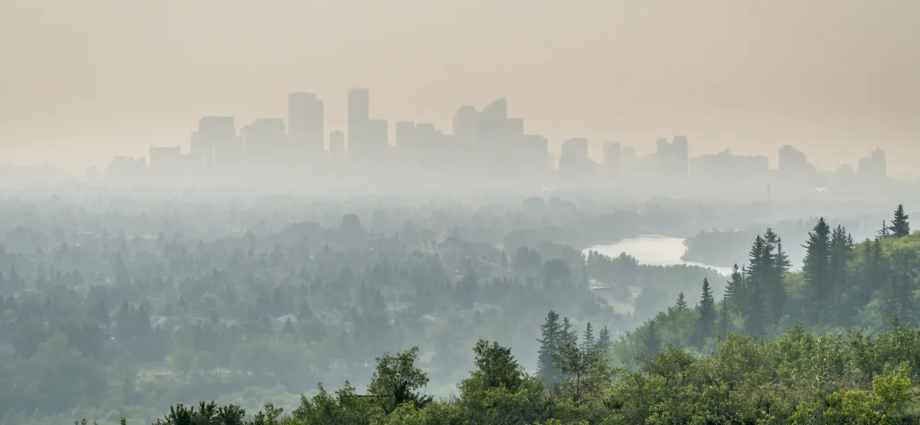COVID-19 recovery is an opportunity to tackle worsening climate crisis: New report
Smoke from wildfires blankets downtown Calgary. (Shutterstock)
Courtney Howard, University of Calgary
We are at a moment of overlapping planetary health emergencies: COVID-19 and climate change. Both have their origins at the intersection of humanity and the rest of the natural world, both exacerbate pre-existing health inequities and both have the ability to bring health systems and economies to their knees.
The health impacts of COVID-19 are well-known — those of climate change less so. A new report by the Lancet Countdown on Health and Climate Change, an international collaboration among 38 leading academic institutions and U.N. agencies, shows that as the globe warms humans are experiencing increasing heat emergencies, wildfires, severe weather, trouble with food yields and potential for novel infectious diseases.
We need to “multisolve” — manage COVID-19 and climate change at the same time, looking for the sweet spots where a single measure can deliver the triple-win of improving public health, contributing to a sustainable economy and reducing the drivers of future crises.
The Canadian policy brief associated with the Lancet report has suggestions for doing just that.

Protect our homes
The report shows a record 2,700 heat-related deaths occurred among people over the age of 65 in Canada in 2018. Globally, the last two decades have seen a 59 per cent increase in heat-related mortality in older people.
The economic costs are also growing: work hours lost due to extreme heat exposure were 81 per cent higher in 2015-19 compared to 1990-94. Immediate action is required.
Many Canadians have had their living circumstances made precarious through COVID-19. In its fall budget update, the federal government announced $1 billion in funding, through the Rapid Housing Initiative, to be used for the construction of modular housing and affordable housing units.
All of the projects funded through this and other federal construction and retrofit programs should be evaluated for their location relative to flood-prone areas, their ability to ensure adequate ventilation and air filtration to cope with heat emergencies and wildfire smoke, and their alignment with our goal of living in a net-zero nation by 2050.
Clean the air
We must also clear the air of the pollution we can control. The Lancet report shows that in 2018 there were 7,200 premature deaths in Canada related to fine particulate air pollution from human-caused sources. This is four times higher than the number of deaths from transport accidents.
The largest portion, found by the Lancet to be over 30 per cent, was due to emissions from households, such as burning fuel for heating. That means that energy efficient retrofits can save lives!
Pollution from cars, trucks and other transport was shown in the report to be responsible for 17 per cent of deaths due to fine particulates in 2018. It is also responsible for 30 per cent of Canada’s greenhouse gas emissions. Investments in zero-emission vehicle infrastructure and collective transport, such as electric vehicle charging stations and electric buses are huge wins for health.

Active transport investments have the added benefit of increasing physical activity, which reduces chronic disease. A recent study showed that compared to those who commute by private motorized vehicles, all-cause mortality was reduced by 20 per cent in those who cycle, and 10 per cent in rail commuters, with walk commuting associated with a seven per cent lower incidence of cancer. In the United Kingdom, investments in cycling infrastructure have been found to deliver about five British pounds of health and social benefits for every pound invested
Build resilience
Finally, we need to increase the resilience of health systems. In addition to ensuring health-care structures are prepared for floods and fires in terms of siting, adequate ventilation systems, and more, we must take another look at supply chains.
We learned through the pandemic that producing personal protective equipment (PPE) at home helps to ensure its availability in the face of supply chain disruption. We’ve also seen the disadvantages of not having the ability to produce the leading COVID-19 vaccines at home.
With climate set to drive further health-related emergencies as well as economic crises a shift from a culture of efficiency to one of resiliency is required. We could decrease our healthcare-related footprint and reduce the risk of supply disruption by switching to reusable medical supplies such as gowns and blood pressure cuffs.
The proposed national formulary, a good first step towards a pharmacare system, can also serve as a list of essential medicines considered for domestic production. Co-ordinated work between the public and the private sector, potentially including the creation of new crown corporations, could help ensure supply of critical items, as it did during the Second World War.
A hinge moment
Canada is now full of armchair epidemiologists, but few of us could draw an approximation of the country’s projected warming curve. A leap in understanding is required: this forecast must inform planning in all sectors.
Canada is warming at about double the global rate. Under all feasible emission scenarios it will be about 1.8C warmer than a 1986-2005 baseline by the time today’s newborns are in their twenties, rising to 6C by the time they are in their 60s if we do not urgently decrease greenhouse gas emissions.
As the Lancet report says, unless immediate action is taken this will threaten not only lives and livelihoods, but also compromise the hospitals and clinics we depend on.
Subscribe to our newsletter.
COVID-19 is a hinge moment in human society — a time to pause, to reset. Although health workers have been appropriately lauded through this pandemic for the care they are providing, it is becoming clear that from wearing masks to retrofitting our homes, we all share the responsibility, and the honour, of saving lives.
Courtney Howard, Clinical associate professor, Department of Family Medicine, Cumming School of Medicine, University of Calgary
This article is republished from The Conversation under a Creative Commons license. Read the original article.

